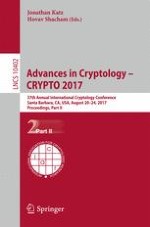2017 | OriginalPaper | Buchkapitel
Incremental Program Obfuscation
verfasst von : Sanjam Garg, Omkant Pandey
Erschienen in: Advances in Cryptology – CRYPTO 2017
Aktivieren Sie unsere intelligente Suche, um passende Fachinhalte oder Patente zu finden.
Wählen Sie Textabschnitte aus um mit Künstlicher Intelligenz passenden Patente zu finden. powered by
Markieren Sie Textabschnitte, um KI-gestützt weitere passende Inhalte zu finden. powered by
